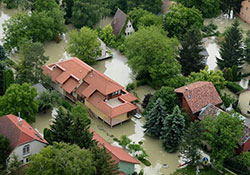A strong agreement from COP21 matters to health – and to the European Region

ORFK/H. Szabó Sándor
Since 30 November 2015, more than 20 000 negotiators from around the world have gathered in Le Bourget, Paris, France, for the 21st annual session of the Conference of the Parties (COP21) to the United Nations Framework Convention on Climate Change (UNFCCC). The conference's objective is to produce a legally binding agreement that commits all nations of the world to taking action on climate change. For nearly 2 weeks, the negotiators have discussed topics ranging from mitigation (reducing greenhouse gas emissions), to adaptation, to financing and more. A draft agreement has been produced, and countries hope to reach a final agreement in the coming days.
COP21 marks "a decisive moment", as WHO Regional Director for Europe Zsuzsanna Jakab said during a high-level side event in Paris on 9 December. World leaders, experts and activists have repeated similar sentiments during the past 2 weeks, including UN Secretary-General Ban Ki-moon. In his remarks at COP21, he said, "The clock is ticking towards climate catastrophe…. Paris must put the world on track for long-term peace, stability and prosperity. The decisions you make here will reverberate down through the ages."
Health effects of climate change
As the Paris negotiations continue, it's important to emphasize why health must play a central role in climate action. Dr Jakab called a climate agreement "critical to public health" during her remarks in Paris, and the data reveal why. A WHO assessment concluded that climate change is expected to cause more than 250 000 additional deaths per year globally between 2030 and 2050. The European Region will not be spared from this impact – climate change recognizes no borders.
The world and the Region must take measures to both mitigate and adapt to climate changes. If left unchecked, climate change can have a grave effect on the Region, including:
- an estimated 15 280 additional heat-related deaths annually in 2030, and 32 152 additional deaths in 2050 for people over 65 years in the Region;
- river flooding that will affect an estimated 250 000–400 000 additional people per year in the European Union by the 2080s, more than doubling the number from the 1961–1990 period;
- changes in the distribution of vectors, such as ticks and mosquitoes, leading to the spread of diseases such as West Nile virus, chikungunya and dengue in the Region;
- lengthening the pollen season, affecting allergic diseases (The pollen season in Europe has already increased by an average of 10–11 days over the past 30 years.);
- an up to a 30% decrease in crop yields in central Asia by mid-century and up to a 25% decrease in southern Europe, leading to serious food insecurity and nutrition issues; and
- a projected 20% decrease in renewable water resources globally per each degree of temperature increase (Celsius) caused by global warming.
A strong climate change agreement could save many lives worldwide.
Investments in low-carbon development, clean renewable energy and greater climate resilience are also investments in better health. For example:
- Measures to reduce air pollution as well as non-CO2 air pollutants such as black carbon, could reduce the 7 million deaths globally and the around 600 000 deaths in the WHO European Region.
- A reform of global energy subsidies could reduce CO2 emissions by more than 20%, cut premature deaths due to air pollution by more than half and raise government revenues by nearly US$ 3 trillion.
- Implementing and enforcing higher standards for vehicle emissions and engine efficiency could reduce emissions of short-lived climate and air pollutants, saving around 2.4 million lives a year and reduce global warming by about half a degree Celsius by 2050.
- Reducing the 4.2% of annual CO2 emitted by European health care could prevent 15 000–30 000 cases of illness.
Health sector measures to address climate change
In order to address the challenges posed by climate change and to create climate-resilient communities, the health sector will probably have to undertake measures such as:
- enhancing disease surveillance, especially for climate-sensitive vector-borne diseases;
- monitoring changing environmental exposures;
- ensuring essential medical supplies and health services during disasters;
- improving preparedness, planning and response for heat-waves and other extreme events; and
- facilitating coordination between health and other sectors to deal with changes in the incidence and geographical range of diseases.
The world is now waiting to see the results of COP21 – whether nations can come to a substantive agreement on how to meet one of the greatest challenges of our time. At this decisive moment, it is critical to remember that climate change threatens not only the world's natural resources. Its potential to affect health and well-being is a major threat to the planet's most valuable resource – its people.



